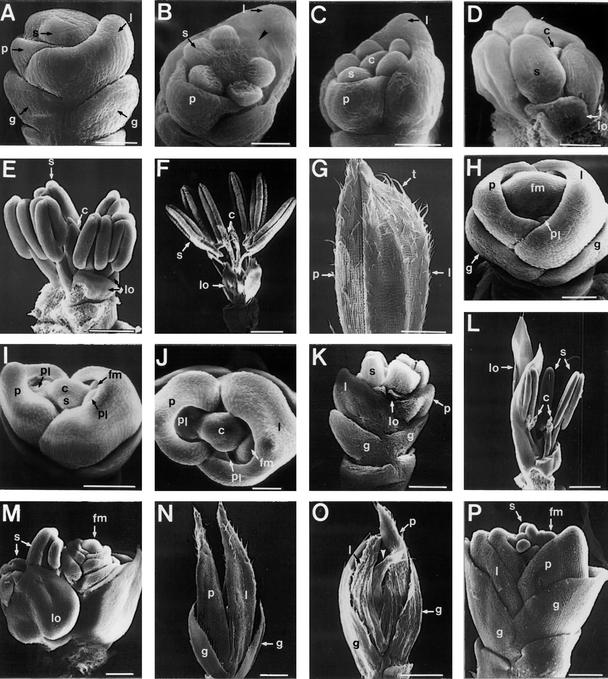Figure 7.
Scanning Electron Microscopy of Wild-Type, lhs1, and Transgenic Spikelets.
Scanning electron microscopy of spikelets of wild-type ([A] to [G]), lhs ([H] to [O]), and transgenic line 2145-9 (P) rice.
(A) In outer whorls, glumes and palea and lemma primordia are formed. The central floral meristem starts initiating stamen primordia.  .
.
(B) Six developing stamens are visible. One stamen primordium is developing late (arrowhead). Removal of the lemma reveals that lodicule primordia form at this stage (data not shown).  .
.
(C) The carpel primordium is apparent.  .
.
(D) A dissected spikelet in which palea and lemma were ripped off. A pair of lodicules is formed between stamens and a lemma.  .
.
(E) In stamens, filaments and anthers are apparently differentiated.  .
.
(F) The mature spikelet in which palea and lemma were ripped off.  .
.
(G) The palea and lemma of a mature spikelet.  .
.
(H) Glume and palea and lemma primordia are formed in outer whorls of a lhs spikelet. In the inner whorls, a new palea- and lemma-like structure is visible.  .
.
(I) Palea- and lemma-like structures and a floral meristem are formed in the inner whorls of the lhs1 spikelet. The central meristem is differentiated to stamens and a carpel.  .
.
(J) Top view of (I).  .
.
(K) The lhs spikelet carries five stamens. Lodicules are formed at the base of the stamens.  .
.
(L) The spikelet consists of leafy lodicules, three stamens, and two carpels. Palea, lemma, and right lodicule were removed.  .
.
(M) The spikelet consists of leafy lodicules, two stamens, and a new flower. Palea and lemma were removed to reveal inner organs. 
(N) A mature spikelet. Because of the leafy characteristic of the palea and lemma, the spikelet is open.  .
.
(O) The spikelet exhibits successive formation of paleae and lemmas (arrowhead).  .
.
(P) Early development of the spikelet from a plant of transgenic line 2145-9. The young spikelet consisted of successive leafy paleae and lemmas and floral primordia.  .
.
c, carpel; fm, floral primordium; g, glume; l, lemma; lo, lodicule; p, palea; pl, palea- and lemma-like structure; s, stamen; t, trichome.

